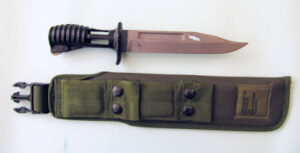









>
A significant contribution to the soldier’s load is ammunition. One way to reduce this is to modify how ammunition is expended.

An assault rifle is not a machine gun. The effective range of an assault rifle with fully automatic fire is considerably less than that of a true machine gun. Full auto from a rifle can be used to sweep a trench or clear a room. It will only be cost-effective at longer ranges if the enemy is in a big dumb bunch. Some manuals state the effective range of a rifle on full-auto as 50 metres. About half of this distance is probably more realistic. If the enemy is more than 50 metres away keep your rifle on semi-automatic.

There will be times when rifles must provide suppressive fire. Think about the Westerns you have seen where a character gets pinned down in the rocks. The Winchesters and revolvers used did not need to go full-auto to do this! Suppress an enemy position with aimed, semi-automatic fire.

If you are moving, concentrate on moving. Tactical movement needs your full attention. You need to be thinking about how you use the cover and concealment available and how you are going to traverse gaps and obstacles. Let other elements provide any suppression. Ideally a moving element should never be visible to an enemy.
Only when an enemy is within a few metres should you be firing and moving.
If you are shooting, concentrate on shooting. Use any cover and concealment as effectively as you can. Use the most stable firing posture that your surroundings allow. Standing or moving is the least accurate posture to shoot from. Prone is the most stable. If you are surprised, take cover first, then return fire. If in the open drop prone and then roll for cover.


Many years ago I came across a statement from the SAS when they were reactivated for operations in Malaya:
Know when to fire and when not to.
“The pegs are not to be hammered in. A hole is made with a bayonet and the pegs driven in with the head” (The head of the peg, presumably, not that of the soldier!)

An interesting idea, but some readers will now be recalling that recently I posted on how the bayonet should be one of the first things a soldier should get rid of.

Last night, I put my SA-80 bayonet on the scales.
The bayonet alone was 15 oz, about the same as my favourite 10" bladed kukri.
The bayonet with scabbard was just over 1 lb 7 oz.
This is the later pattern of scabbard without the useful wire cutter and woodsaw fittings.
The blade is a sort of bowie-like shape so not sure how well it will poke peg holes in hard ground.
The author of the about passage was probably talking about sword bayonets. The later issue spike bayonet might be even more useful.
















